Synthesis, characterization, and design of molecular materials, especially molecular conductors (including superconductors ), have been undertaken. Molecular conductors exhibit a variety of physical properties which can be systematically understood on the basis of "simple" and "clear" electronic structures. From a chemical point of view, the most fascinating character of the molecular conductor is its "designability", that is, we can finely control solid state properties with chemical modifications of the molecule. The newly synthesized materials are characterized by the X-ray diffraction method and physical measurements (electrical conductivity...etc.). The electronic structure is investigated by the simple band structure calculation. All these results are devoted to the design of new molecular materials.
- Magnetic susceptibility measurements of the Pd(dmit)2 salts under pressure
- The methodology for studying lattice, charge, and orbital of metal-dmit complexes using the vibrational spectroscopy
- The intra-dimer charge separation of dimerized Pd(dmit)2 salt
- The electron-lattice interaction on the pseudo-triangular lattice of Pd(dmit)2 salts
- Supramolecular anion radical salt (Me-3,5-DIP)[Ni(dmit)2]2 where localized spins and conduction electrons coexist
- Development of molecular conductors based on novel metal dithiolene complexes
(1) Physical properties of molecular conductors based on unsymmetrical square planar metal dithiolene complex [(ppy)AuIII(C8H4S8)] (ppy- = C-deprotonated-2- phenylpyridine)
(2) Development of molecular conductors based on multimetallic dithiolene complexes with a bridging tetrathiooxalate (tto) ligand
(3) Development of molecular conductors based on Ni-dddt complexes with cycloalkane - Transport property of massless Dirac fermions in organic conductors
- Magnetoresistance effect and Hall effect in strongly correlated electron systems
- Nano-/micro-crystal of molecular conductors on silicon substrate
- Development of novel oligo-thiophenes having orthogonal molecular geometry for organic field effect transistors (OFETs)
- Anisotropy of nonlinear optical responses in organic molecules and semiconductor nanocrystals
- Magnetic susceptibility measurements of the Pd(dmit)2 salts under pressure
- The methodology for studying lattice, charge, and orbital of metal-dmit complexes using the vibrational spectroscopy
- The intra-dimer charge separation of dimerized Pd(dmit)2 salt
- The electron-lattice interaction on the pseudo-triangular lattice of Pd(dmit)2 salts
- Supramolecular anion radical salt (Me-3,5-DIP)[Ni(dmit)2]2 where localized spins and conduction electrons coexist
- Development of molecular conductors based on novel metal dithiolene complexes
- Transport property of massless Dirac fermions in organic conductors
- Magnetoresistance effect and Hall effect in strongly correlated electron systems
- Nano-/micro-crystal of molecular conductors on silicon substrate
- Development of novel oligo-thiophenes having orthogonal molecular geometry for organic field effect transistors (OFETs)
- Anisotropy of nonlinear optical responses in organic molecules and semiconductor nanocrystals
We have developed a technique for precise magnetic measurements under high pressure by use of 2 GPa-class high pressure cell, and applied this technique to studying high pressure properties of spin-1/2 triangular Mott insulators, the Pd(dmit)2 salts. We have observed change in paramagnetic susceptibility of Et2Me2Sb[Pd(dmit)2]2, which shows a first-order phase transition to a nonmagnetic state at 70 K under ambient pressure. The transition temperature takes a maximum near 0.6 GPa, where a crossover from the Mott insulating state to metallic state occurs in the high temperature phase. The paramagnetic susceptibility just above the transition temperature decreases with pressure up to 0.6 GPa, followed by nearly constant behavior at higher pressures. No discontinuity was found around this crossover. (dmit = 1,3-dithiol-2-thione- 4,5-dithiolate)
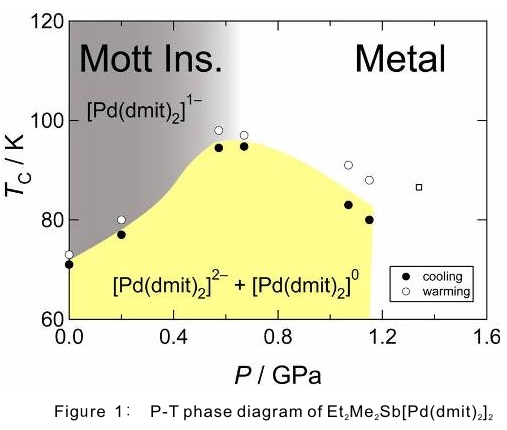
↑Top
The methodology for studying lattice and charge of the M(dmit) salts using the vibrational spectroscopy had not been presented so far owing to a lack of accurate assignments for the C=C stretching modes. As a first step, we have confirmed the assignments of the C=C stretching modes and investigated the detailed properties of these modes based on the experimental results for numerous Pd(dmit)2 salts and quantum chemical calculations. When Pd(dmit)2 molecules form a dimer with weak or negligibly weak interaction, the behavior of the C=C stretching modes is comparable to that of the BEDT-TTF salts. When Pd(dmit)2 molecules form a dimer with strong interaction, on the other hand, not only the symmetric mode but also the asymmetric mode are largely perturbed by the coupling with the charge transfer transition. Our assignment answers why the additional band is always observed in the vibrational spectra of the dimerized Pd(dmit)2 salts.
In the next step, we have developed the methodology for investigating the molecular charges, the lattice distortion, and the orbital redistribution, by using the Pd(dmit)2 salts; Et2Me2Sb[Pd(dmit)2]2 and Cs[Pd(dmit)2]2, both of which exhibit inter-dimer charge ordered (CO) transition due to the orbital redistribution. The unperturbed asymmetric mode shows peak splitting below the CO transition temperature. This observation conforms that the unperturbed asymmetric mode is sensitive to the molecular charge. Interestingly, the largely perturbed asymmetric mode also exhibits peak splitting below the CO transition temperature. This phenomenon indicates that the inter-dimer interaction less contributes to the perturbation of the asymmetric mode whereas the intra-dimer interaction has a remarkable contribution to the perturbation. Throughout the factor group analysis solely, the distribution of the molecular charges in the CO state is obtained, wherein a repeating unit consists of two charge poor dimers and two charge rich dimers. The obtained distribution is in agreement with that from the X-ray structural analysis.
Throughout the detailed factor group analysis thoroughly, we have evidenced the loss of the inversion symmetry in the CO state of both materials. The loss of the inversion symmetry is ascribed to the fluctuation of the lattice at the charge rich dimers. Since inter-molecular distance of the present materials is large, the charge rich dimers can take several kinds of tetramerization. Interestingly, the fluctuation of the lattice and charges remain in the high temperature phase of Cs[Pd(dmit)2]2. These observations are significantly different from the results of the X-ray structural analysis. Therefore, we have shown that the vibrational spectroscopy is one of the most powerful methods to investigate the charge, lattice and orbital degrees of freedom.
(dmit = 1,3-dithiol-2-thione- 4,5-dithiolate, BEDT-TTF = bis(ethylenedithio)tetrathiafulvalene)
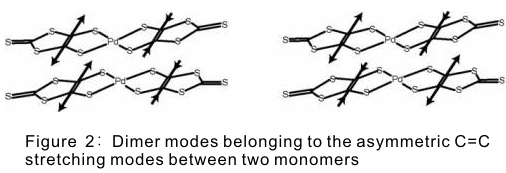
↑Top
It had been believed that the physical properties of the dimerized molecular conductors can be mapped with the on-site Coulomb energy at a dimer, Udimer, and the inter-dimer transfer integral, tinter. Based on the above model, the time-averaged molecular charges within a dimer can be regarded as uniform. However, it is reasonable to consider that the absence of the intra-dimer charge separation for the dimerized materials indicates that the charge ordered transition for the dimerized system requires an additional factor. We have examined the intra-dimer charge separation using the vibrational spectroscopy of triclinic-EtMe3P[Pd(dmit)2]2 which shows non-magnetic insulating behavior below 70 K. As we have expected, the intra-dimer charge separation is observed below the transition temperature. The observation of the intra-dimer charge separation is ascribed to the structural properties of the β'-type Pd(dmit)2 salts along with the inter-molecular Coulomb interaction, V. The Pd(dmit)2 dimers form a columnar structure and columnar structures form a two dimensional layer, which is significantly different from the absence of the columnar structure in the κ-type BEDT-TTF salts. Owing to the columnar structure, the tetramerization supports the localization of the site charge due to V. The intra-dimer charge separation also requires the tight inter-molecular distance because the loose distance induces the perturbation of the energy levels in the frontier orbitals resulting in the inter-dimer charge separation. The fluctuation (disorder) in the lattice distortion is observed (remains) above (below) the transition temperature. When two charges are accommodated into a tetramer, two kinds of symmetric tetramers are allowed. According to the studies on the inter-dimer charge separation for Et2Me2Sb[Pd(dmit)2]2 and Cs[Pd(dmit)2]2, the transfer integral between charge poor molecules is larger than that between charge rich molecules. This mechanism supports the reduction (enhancement) of one of tetramers below the transition temperature.
From the viewpoint of the structural property, the β'-type Pd(dmit)2 salts are situated between the κ-type BEDT-TTF salts and the β''-type BEDT-TTF salts. As for the previously synthesized β'-type Pd(dmit)2 salts, the physical properties are almost comparable to those of the κ-type BEDT-TTF salts. On the other hand, the conducting properties of the β''-type BEDT-TTF salts, which are non-dimerized or weakly dimerized materials, are mapped with degree of fluctuation in the molecular charges. Therefore, the newly synthesized β'-type Pd(dmit)2 salts, which exhibits fluctuation or localization due to the charge separation, will belong to a key system which leads to a general understanding for the conducting and magnetic properties of these molecular conductors.
(dmit = 1,3-dithiol-2-thione- 4,5-dithiolate, BEDT-TTF = bis(ethylenedithio)tetrathiafulvalene)
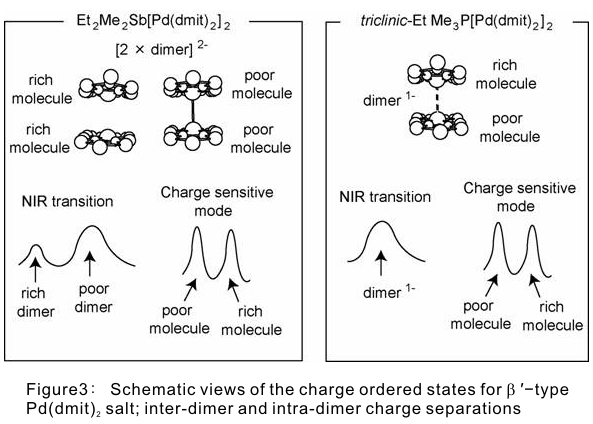
↑Top
The molecular dimers in monoclinic-EtMe3P[Pd(dmit)2]2 form a pseudo-triangular lattice. This material is not an anti-ferromagnetic insulator but a non-magnetic insulator due to the tetramerization below 25 K. In the pressure-temperature phase diagram, it has been revealed that the superconductor phase is neighbored with non-magnetic insulator phase. On the other hand, EtMe3Sb[Pd(dmit)2]2 is thought to be most close to the triangular lattice, which is confirmed by temperature dependence of the magnetic susceptibility and 13C-NMR. The Pd(dmit)2 molecules form two dimensional conducting layer ant the conducting layer contains the columnar structure. Therefore, the difference in the magnetic behavior between these two salts should be ascribed not only to the deviation from ideal triangular lattice but also to the degree of tetramerization. We have studied degree of tetramerization for both materials using vibrational spectroscopy.
The tetramerization mode is detected for both materials, and the time-averaged molecular charges are almost uniform. The tetramerized structure is well developed for monoclinic-EtMe3P[Pd(dmit)2]2 as compared with EtMe3Sb[Pd(dmit)2]2. Since the Pd(dmit)2 dimers form almost uniform columnar structure, at least two kinds of tetramerized structure are allowed. The development of one of the tetramer structures inhibits a spin frustration for monoclinic-EtMe3P[Pd(dmit)2]2. Therefore, the spin frustration for the β'-type Pd(dmit)2 salts requires the reduction of the tetmerization along with the spatial isotropic structure.
(dmit = 1,3-dithiol-2-thione- 4,5-dithiolate)
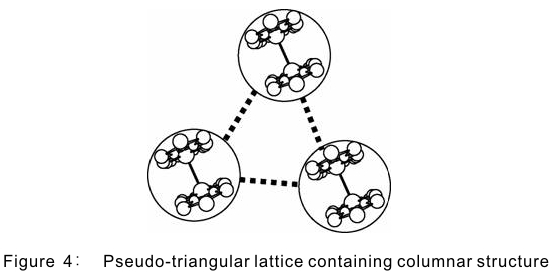
↑Top
(Me-3,5-DIP)[Ni(dmit)2]2 is an anion radical salt having supramolecular interactions between the cation and Ni(dmit)2 anion. This salt consists of two crystallographically independent Ni(dmit)2 layers (Layers I and II), where Layer I has localized spins and Layer II has conduction electrons, respectively. We investigated the electrical resistivity under pressure to find the phenomena which come from the interplay of conducting and magnetic electrons. Under hydrostatic pressure, the metallic behavior is enhanced along the in-plane directions. On the other hand, the resistivity still shows insulating behavior along the interlayer direction. In a low temperature region, the resistivity shows -logT dependence along each direction. The -logT dependence is also observed in the resistivity under uniaxial strain along the interlayer axis. These suggest the possibility that the Kondo-singlet-like state is formed in this system.
(Me-3,5-DIP = N-methyl-3,5-diiodopyridinium, dmit = 1,3-dithiol-2-thione- 4,5-dithiolate)
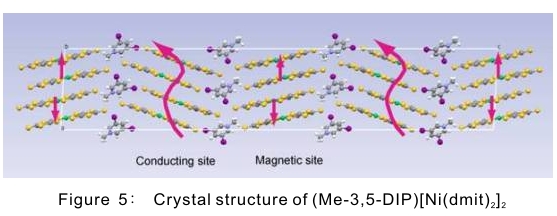
↑Top
(1) Physical properties of molecular conductors based on unsymmetrical square planar metal dithiolene complex [(ppy)AuIII(C8H4S8)] (ppy- = C-deprotonated-2- phenylpyridine)
We have studied physical properties of the cation radical salts derived from organometallic mixed-ligand complexes, [(ppy)Au(C8H4S8)] (ppy- = C-dehydro-2- phenylpyridine(-); C8H4S82- = 2-{(4,5-ethylenedithio)-1,3-dithiole-2-ylidene}-1,3-dithiole-4,5-dithiolate(2-)) with Au(III)-C σ-bond. Previous results of resistivity measurement under pressure, tight-binding band calculation, and magnetic susceptibility measurement suggest that [(ppy)Au(C8H4S8)]2[PF6] has a quasi-one dimensional character and ground state of the salt is a Mott insulating state. In order to determine the ground state exactly, infrared reflectance and Raman spectra were measured. Raman spectra show three peaks which are associated with three C=C double bonds on the dithiolene ligand. These peaks do not shift by variation in temperature (300 K -10 K), indicating that the molecular charges do not change in this temperature region. The infrared spectra were measured along each crystallographic axis. In the E||c spectra, only sharp vibrational peaks are distinct, and the electronic contribution is negligible. The electronic contribution of the b*-polarized spectra is finite, but very small below 2000 cm-1. On the other hand, the reflectance spectrum for E||a exhibits a broad maximum around 2500 cm-1. The quasi-one dimensional electronic structure is evident. The spectrum along the a axis exhibits a broad vibronic peak (1100 cm-1) which is explained by the CT transitions occurring in a dimeric structure. These results suggest that the salt is a Mott insulator close to the metal-insulator boundary under ambient pressure. Our results represent a valuable contribution to the advancement of molecular materials based on organometallic compounds.

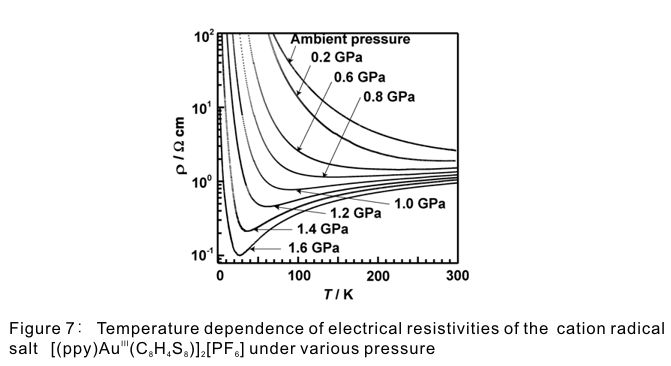
↑Top
(2) Development of molecular conductors based on multimetallic dithiolene complexes with a bridging tetrathiooxalate (tto) ligandPreviously, we have succeeded in preparation and crystallization of trimetallic and bimetallic complexes with tto bridging ligands ([(tto)2Ni3(S-S)2]2- and [(tto)Ni2(S-S)2]2-; S-S = dmit, dmise, tdas, dddt, edo; dmit = 1,3-dithiole-2-thion-4,5-dithiolete; dmise = 1,3-dithiole-2-selenon-4,5-dithiolete; tdas = 1,2,5-thiadiazole-3,4-dithilate; dddt = 5,6-dihydro-1,4-dithiine-2,3-ditholate; edo = 5,6-dihydro-1,4-dioxine-2,3-dithiolate). Spectroscopic measurements and MO calculations of the complexes were performed. In particular, UV-VIS-NIR spectra are necessary for determination of fundamental physical properties of molecular conductors such as HOMO-LUMO gap. However, no report exists about the spectroscopic study. We measured the spectra of the complexes. The analysis of the spectra is now in progress at RIKEN RSCC system. Electrochemical crystallization was also successful. Single crystals of trimetallc complex were obtained. The X-ray crystallographic analyses are now in progress.
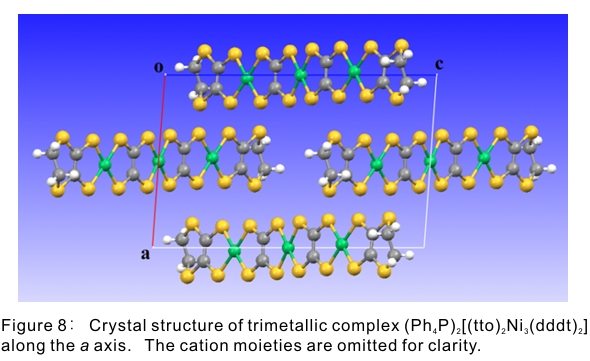
↑Top
(3) Development of molecular conductors based on Ni-dddt complexes with cycloalkaneThe acceptor type metal bis-dithiolene complexes including [M(dmit)2] (M = Ni, Pt and Pt) have been extensively studied, and are known to provide various anion radical salts which exhibit superconducting and metallic behavior. The donor-type metal bis-dithiolene complexes are also promising materials for molecular conductors. For example, M(dddt)2 (M = Ni, Pd, Pt and Au) can provide various molecular conductors. [Ni(dddt)2]3(AuBr2)2 (3:2 salt) is the first metallic cation radical salt of metal dithiolene complex which is stable down to at least 1.3 K. However, no metal and superconductor based on the donor type metal bis-dithiolene complexes has been reported except for the 3:2 salt. We designed new donor molecules based on Ni-dddt complex with cycloalkane as terminal substituents, and prepared the donor molecules with cyclopentane, cyclohexane, cycloheptane and cyclooctane. X-ray crystallographic analysis and spectroscopic study of the complexes were performed. Electrochemical crystallization was also successful. Single crystals of radical cation salts of the complexes with cyclopentane were obtained (I3-, IBr2-, PF6-, BF4-, ClO4-). X-ray crystallographic measurements and other physical measurements are now in progress.

↑Top
A zero-gap state with the Dirac cone type energy dispersion has been found in an organic conductor α-(BEDT-TTF)2I3 under high hydrostatic pressures. This is the first two-dimensional zero-gap state discovered in bulk crystals with layered structure. In this work, out-of-plane magnetoresistance of this system was investigated at low temperatures. The purpose is to clarify a characteristic feature of the bulk zero-gap system. When magnetic field (B) was applied along the normal of the 2D plane, the magnetoresistance (M) decreased as a function of M∝B-1. This result strongly suggests that this material is a truly zero-gap conductor with the Dirac cone type energy dispersion. In the zero-gap system, N=0 Landau level called zero-mode appears at E=0 under the magnetic field. The negative out-of-plane magnetoresistance is associated with increase in the density of states which is proportional to the strength of magnetic field on the zero-mode Landau level.
(BEDT-TTF = bis(ethylenedithio)tetrathiafulvalene)
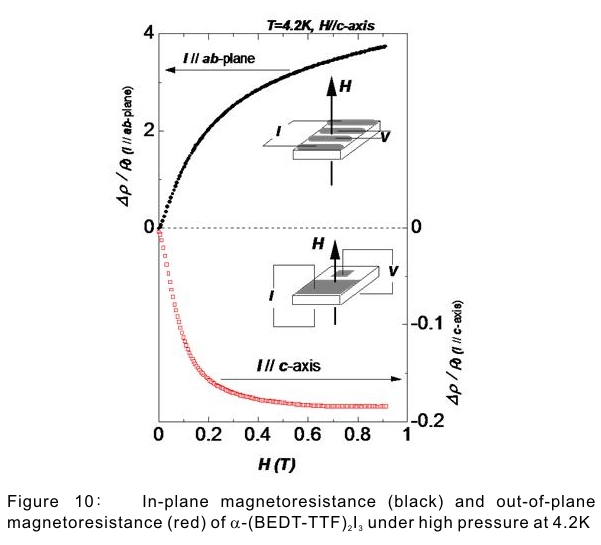
↑Top
We have investigated temperature dependence of the Hall coefficient and the resistivity of an organic Mott insulator, β'-(BEDT-TTF)2ICl2 under ambient and hydrostatic pressures up to 2 GPa. The charge gap, the effective mass and the scattering lifetime of carriers on the Mott Hubbard bands were evaluated by analyzing these transport properties. We found that the effective mass, m*, and the charge gap, Δ, can be written approximately as 1/m*∝(1-Δ/Ueff) in low pressure region and have evaluated the value of the effective on-site Coulomb energy Ueff as ∼445 meV. Moreover, we revealed that the effective scattering lifetime is proportional to the averaged distance between carriers in the two dimensional plane, which suggests an existence of the scattering process attributable to carrier-carrier umklapp scattering in the Mott insulating state.
(BEDT-TTF = bis(ethylenedithio)tetrathiafulvalene)
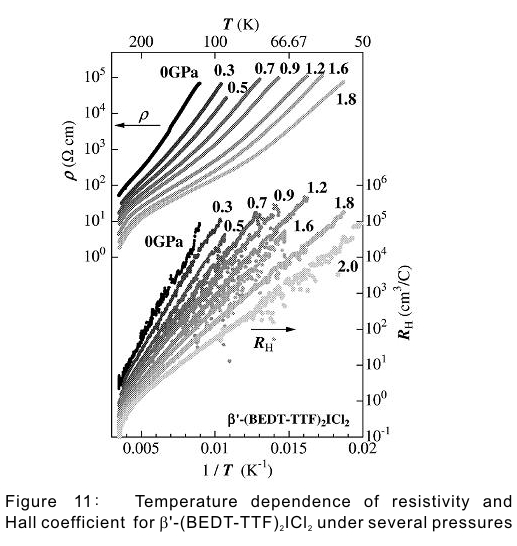
↑Top
Electric properties of nano/micro- crystals of molecular conductors directly grown on SiO2/Si++ substrates were examined. In our previous experiment, (DMe-DCNQI-d7)2Cu nanocrystal was found to show no metal-insulator (M-I) transition upon cooling, despite its bulk crystal exhibited sharp M-I transition at 80 K. Our new experiment revealed that the bulk crystal also showed no M-I transition down to 4 K when it was fixed on a SiO2/Si++ substrate with carbon paste and epoxy resin. This is because the small thermal expansion coefficient of the silicon substrate induces pseudo negative pressure upon the soft organic crystal whose thermal expansion coefficient is several dozen times larger.
α-(BEDT-TTF)2I3 and κ-(BEDT-TTF)2Cu[N(CN)2]Br single crystals were also grown on SiO2/Si++ substrates. Their field effect transistor properties were measured in their low-temperature insulating phases, the former of which is a charge ordered state and the latter of which is a Mott insulating state. κ-(BEDT-TTF)2Cu[N(CN)2]Br is normally a superconductor in its ground state, but when it is fixed on the hard silicon substrate, it falls into the insulating ground state due to the pseudo negative pressure from the substrate. The device properties such as ON/OFF ratio and the field effect mobilities have been quite improved by optimizing the crystal growth conditions and choosing good crystals as well as device configuration.
(DMe-DCNQI = 2,5-Dimethyl-N,N'-Dicyanobenzoquinonediimine, BEDT-TTF = bis(ethylenedithio)tetrathiafulvalene)
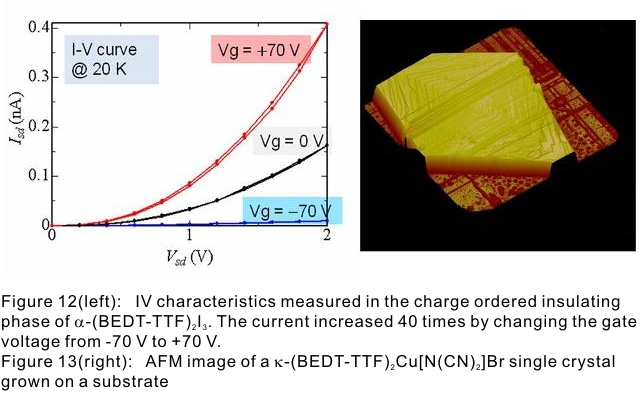
↑Top
We have developed new organic semiconductors and investigated their FET performance, in which we focus on molecular order in their thin films from solution process.
We have newly prepared oligo-thiophenes having orthogonal molecular geometry due to trialkylsilyletynyl groups. These molecules have excellent solubility in common organic solvents applicable for wet-process device fabrication. We expect systematic change of their crystal structures in crystalline thin films based on self-aggregation of trialkylsilyletynyl groups.
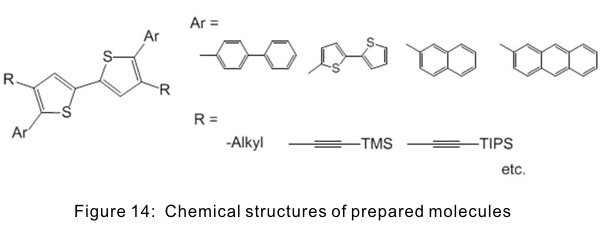
↑Top
Microscopic molecular symmetry and macroscopic molecular orientation affect nonlinear optical responses and their anisotropy. Molecular orientation is also affected by the molecular symmetry. In this fiscal/academic year, first-order electroabsorption spectroscopy was applied to characterize nonlinear optical property of vacuum-deposited tris(8-hydroxyquinolinato) aluminum(III) (Alq3) thin films which show spontaneous buildup of giant surface potential (GSP) as high as 28 V at 560 nm thickness. 2nd-order nonlinear optical susceptibility χ(2) was determined to be on the order of 1×10-8 esu, which is close to the values of widely used inorganic nonlinear optical materials. Considering the fact that 2nd-order nonlinear optical activity can be obtained by just vacuum deposition without any poling process, Alq3 is a promising material for nonlinear optical applications.
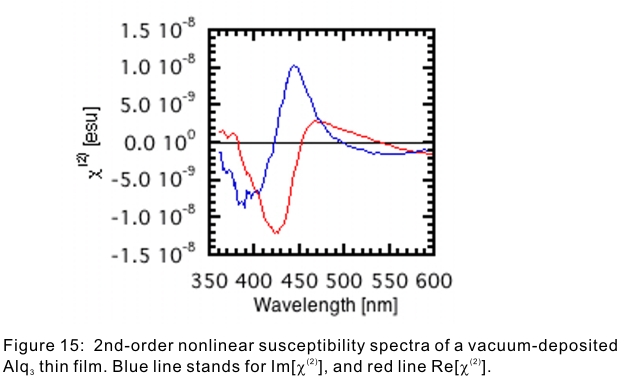
↑Top












